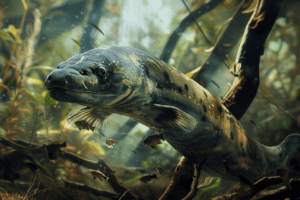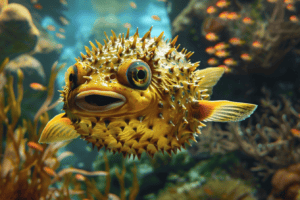The Coelacanth, also known as the “living fossil,” is a prehistoric fish that has puzzled scientists for centuries.
This ancient creature was thought to have gone extinct over 65 million years ago, but in 1938, a live Coelacanth was discovered off the coast of South Africa.
Since then, scientists have been studying this elusive fish to learn more about our planet’s history and evolution.

The Coelacanth is a fascinating creature that is often referred to as a “time capsule.” It has remained virtually unchanged for millions of years, providing us with a glimpse into the prehistoric seas.
The Coelacanth has unique characteristics, such as its four fleshy fins, which resemble limbs, and its hollow spine, which is filled with oil instead of marrow.
These features have allowed the Coelacanth to adapt and survive in deep-sea environments for millions of years.
Despite being a living fossil, the Coelacanth is still shrouded in mystery.
Scientists have only been able to study a few specimens, and much of its behavior and life cycle remain unknown.
However, recent advancements in technology have allowed researchers to learn more about this ancient fish, and they continue to make new discoveries.
The Coelacanth is a fascinating creature that reminds us of the wonders and mysteries of our natural world.
Discovering the Coelacanth
History of Discovery
The Coelacanth, a prehistoric fish, was thought to have gone extinct 66 million years ago.
However, in 1938, a fisherman in South Africa caught a strange-looking fish that resembled the Coelacanth.
The fisherman brought the fish to a museum where it was identified as a Coelacanth.
This discovery was a huge surprise to the scientific community, as it was believed that the Coelacanth had been extinct for millions of years.
Since then, more Coelacanths have been found in the waters off the coast of South Africa, Madagascar, and Indonesia.
Scientists have learned a lot about the Coelacanth from studying these living fossils.
They have discovered that the Coelacanth has several unique features that have helped it survive for millions of years.
The Coelacanth’s Habitat
Coelacanths live in deep waters, usually at a depth of around 500 feet. They prefer rocky areas and underwater caves where they can hide from predators.
Coelacanths are found in the Indian Ocean and the waters around Indonesia. They are also found in the Comoros Islands, where they are protected by law.
Coelacanths are slow-moving fish that feed on smaller fish and squid.
They have a unique way of swimming that allows them to conserve energy while moving through the water.
Scientists believe that the Coelacanth’s slow metabolism and unique swimming style have helped it survive for millions of years.
In conclusion, the discovery of the Coelacanth was a major scientific breakthrough that has helped us understand more about prehistoric sea life.
The Coelacanth’s unique features and habitat have made it a fascinating subject of study for scientists around the world.
Anatomy of a Living Fossil

Unique Physical Traits
The Coelacanth, also known as the “living fossil,” is a rare and fascinating fish that has survived for millions of years.
This prehistoric creature has some unique physical traits that set it apart from other fish.
One of the most striking features of the Coelacanth is its four muscular lobed fins, which resemble the limbs of a land animal.
These fins are used to help the Coelacanth swim and maneuver in the water.
Another interesting physical characteristic of the Coelacanth is its large, round eyes.
These eyes are adapted to low light conditions, allowing the fish to see in the deep, dark waters where it lives.
The Coelacanth also has a unique organ called the “rostral organ,” which is located on its snout.
The purpose of this organ is still unknown, but scientists believe it may be used for detecting prey or sensing changes in water pressure.
Swimming Through Time
The Coelacanth has been swimming through time for over 400 million years.
This fish was thought to have gone extinct 66 million years ago, but in 1938, a living Coelacanth was discovered off the coast of South Africa.
Since then, more Coelacanths have been found in the waters around Africa, Indonesia, and the Comoros Islands.
The Coelacanth’s ability to survive for millions of years is due in part to its unique physical traits.
Its four lobed fins, for example, allowed it to move from shallow waters to deeper waters, where it could avoid predators and find new sources of food.
The Coelacanth’s large eyes and rostral organ also helped it adapt to its environment and survive over time.
In conclusion, the Coelacanth is a fascinating creature with unique physical traits that have helped it survive for millions of years.
Its ability to adapt to changing environments and avoid predators has allowed it to swim through time and provide us with a glimpse into the prehistoric seas.
Coelacanth’s Biology and Behavior

Reproduction and Lifespan
Coelacanths are known for their slow growth rate and long lifespan. These fish have a gestation period of about 13 months and can live up to 60 years.
They reach sexual maturity at around 20 years of age, and females give birth to live young. This is a unique trait in fish, as most lay eggs.
Diet and Predation
Coelacanths are carnivorous and feed on a variety of prey, including fish, squid, and crustaceans.
Their diet varies depending on their habitat and the availability of food.
Coelacanths have few natural predators, but they are sometimes caught by sharks and other large fish.
Coelacanths have a unique biology that has remained relatively unchanged for millions of years.
Their slow growth rate and long lifespan make them a fascinating subject of study.
While they were once thought to be extinct, their discovery in the 20th century has given scientists a glimpse into prehistoric seas and the evolution of life on Earth.
Conservation Efforts

Threats to Survival
Despite being a living fossil, the Coelacanth is still under threat.
The biggest danger to their survival is overfishing, as they are often caught as bycatch in deep-sea trawling nets.
Habitat destruction is also a concern, as bottom trawling can damage the rocky outcrops where the Coelacanth lives.
Additionally, pollution and climate change are also potential threats to their survival.
Protecting the Coelacanth
To protect the Coelacanth, several conservation efforts have been put in place.
One of the most significant is the establishment of marine protected areas (MPAs) where fishing is restricted or banned altogether.
The first MPA was established in the Comoros in 2001, and since then, several more have been created in other parts of the Indian Ocean.
Another measure taken to protect the Coelacanth is the implementation of regulations on deep-sea trawling.
These regulations aim to reduce bycatch and prevent damage to the Coelacanth’s habitat.
Additionally, education and awareness programs have been developed to promote the conservation of the Coelacanth and its habitat.
Thanks to these conservation efforts, the Coelacanth population has stabilized, and there is hope for their continued survival.
However, continued monitoring and protection are necessary to ensure that this remarkable species remains a part of our planet’s biodiversity for future generations to enjoy.
Fun Fact: The Coelacanth has been around for over 400 million years, making it older than dinosaurs!
Frequently Asked Questions

Why are coelacanths considered a window into our prehistoric oceans?
Coelacanths are considered a window into our prehistoric oceans because they have remained virtually unchanged for over 300 million years.
These ancient fish give us a glimpse into what life was like in the oceans during the time of the dinosaurs.
How has the coelacanth’s anatomy remained unchanged over millions of years?
The coelacanth’s anatomy has remained unchanged over millions of years due to its unique adaptations.
Its sturdy, armor-like scales and powerful fins allow it to swim effortlessly through the water, while its unique lung-like organs allow it to survive in low-oxygen environments.
What habitats do coelacanths prefer, and where can they typically be found?
Coelacanths are deep-sea fish that prefer rocky, underwater caves and crevices.
They are typically found in the Indian Ocean near the Comoros Islands, but have also been spotted near the coast of South Africa and Indonesia.
How many species of coelacanth are known to exist today?
There are two known species of coelacanth that exist today: the West Indian Ocean coelacanth and the Indonesian coelacanth.
Both species are considered endangered due to overfishing and habitat destruction.
What challenges do coelacanths face in their natural environment?
Coelacanths face many challenges in their natural environment, including overfishing, habitat destruction, and pollution.
They are also slow-growing and have a low reproductive rate, which makes them especially vulnerable to population declines.
How do scientists study coelacanths without disturbing their deep-sea habitats?
Scientists study coelacanths using remote-operated vehicles (ROVs) and submersibles.
These devices allow scientists to observe coelacanths in their natural habitat without disturbing their deep-sea environment.
Scientists also use DNA analysis and other non-invasive techniques to study coelacanths without harming them.









